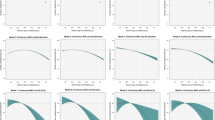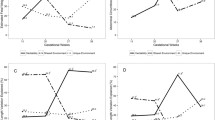Abstract
Objectives Our research provides evidence on the intergenerational fetal programming effect by examining associations in the low birth weight (LBW, birth weight <2500 g) and intrauterine growth restriction (IUGR) status between two adjacent generations from both the maternal and paternal sides. Methods Birth certificate data of the entire Taiwanese population are used to construct three-consecutive-generational samples. The final samples consist of the third-generation children born during 1999–2006 to at least one second-generation (G2) parent born during 1978–1985. Maternal and paternal samples are distinguished based on the gender of G2. We first fit the samples with linear probability models while including extensive explanatory variables to control for myriad confounding factors. We then include G2 sibling fixed effects to account for family-specific heterogeneity. Alternative explanations of sample selection, parents’ assortative mating, and grandmothers’ postnatal investment are examined. Results We find that significant intergenerational associations in LBW and IUGR only occur matrilineally. Children born to LBW mothers are 2.28 (95% CI, 0.71–3.85; p < 0.01) percentage points, corresponding to 36%, more likely to be LBW compared to children born to non-LBW mothers who are sisters. These associations cannot be explained by the above alternative explanations. Conclusions Under G2 sibling comparisons, children born to LBW (IUGR) mothers are more likely to be LBW (IUGR), but children born to LBW (IUGR) fathers are not. The findings suggest that maternal health is pertinent and that socio-economic interventions may not yield the desired outcomes within a short period of time.
Similar content being viewed by others
References
Almond, D., & Currie, J. Killing me softly: the fetal origins hypothesis. The Journal of Economic Perspectives 2011; pp. 153–172.
Alwasel, S. H., Harrath, A., Aljarallah, J. S., Abotalib, Z., Osmond, C., Omar, S. Y., Khaled, I., & Barker, D. J. (2013). Intergenerational effects of in utero exposure to Ramadan in Tunisia. American Journal of Human Biology, 25(3), 341–343.
Barker, D. J. (1990). The fetal and infant origins of adult disease. British Medical Journal, 301(6761), 1111.
Barker, D. J. (1995). Fetal origins of coronary heart disease. British Medical Journal, 311(6998), 171–174.
Brown, M. A., Davis, G. K., & McHugh, L. (2001). The prevalence and clinical significance of nocturnal hypertension in pregnancy. Journal of Hypertension, 19(8), 1437–1444.
Buchbinder, A., et al. (2002). Adverse perinatal outcomes are significantly higher in severe gestational hypertension than in mild preeclampsia. American Journal of Obstetrics and Gynecology, 186(1), 66–71.
Collins, J. W., David, R. J., Prachand, N. G., & Pierce, M. L. (2003). Low birth weight across generations. Maternal and Child Health Journal, 7(4), 229–237.
Collins, J. W., Wu, S. Y., & David, R. J. (2002). Differing intergenerational birth weights among the descendants of US-born and foreign-born Whites and African Americans in Illinois. American Journal of Epidemiology, 155(3), 210–216.
Currie, J., & Moretti, E. Biology as destiny? Short- and long-run determinants of intergenerational transmission of birth weight. Journal of Labor Economics 2007, 25 (2).
Drake, A. J., & Walker, B. R. (2004). The intergenerational effects of fetal programming: Non-genomic mechanisms for the inheritance of low birth weight and cardiovascular risk. Journal of Endocrinology, 180(1), 1–16.
Fung W., Ha W. 2009. Intergenerational effects of the 1959-61 China famine. Risk, Shocks and Human Development. Palgrave Macmillan: Basingstoke.
Gluckman, P. D., Hanson, M. A., & Beedle, A. S. (2007). Non-genomic transgenerational inheritance of disease risk. BioEssays: news and reviews in molecular, cellular and developmental biology, 29(2), 145–154.
Hales, C. N., & Barker, D. J. (2001). The thrifty phenotype hypothesis. British Medical Bulletin, 60(1), 5–20.
Jablonka E., Lamb M. J. (2006). Evolution in four dimensions: Genetic, epigenetic, behavioral, and symbolic variation in the history of life. MIT Press: Cambridge
Klebanoff, M. A., Secher, N. J., Mednick, B. R., & Schulsinger, C. (1999). Maternal size at birth and the development of hypertension during pregnancy: A test of the Barker hypothesis. Archives of Internal Medicine, 159(14), 1607–1612.
Kramer, M. S. (1987). Determinants of low birth weight: Methodological assessment and meta-analysis. Bulletin of the World Health Organization, 65(5), 663.
Kuzawa, C. W., & Sweet, E. (2009). Epigenetics and the embodiment of face: Developmental origins of US racial disparities in cardiovascular health. American Journal of Human Biology, 21(1), 2–15.
Lang, U., et al. (2003). Uterine blood flow-A determinant of fetal growth. European Journal of Obstetrics and Gynecology and Reproductive Biology, 110, S55–S61.
Levitt, N. S., et al. (2000). Impaired glucose tolerance and elevated blood pressure in low birth weight, nonobese, young south African adults: Early programming of cortisol axis. The Journal of Clinical Endocrinology and Metabolism, 85(12), 4611–4618.
Lumey, L. H. (1992). Decreased birthweights in infants after maternal in utero exposure to the Dutch famine of 1944–1945. Paediatric and Perinatal Epidemiology, 6(2), 240–253.
Magnus, P., Gjessing, H. K., Skrondal, A., & Skjaerven, R. (2001). Paternal contribution to birth weight. Journal of Epidemiology and Community Health, 55(12), 873–877.
McTernan, C. L., et al. (2001). Reduced placental 11β-hydroxysteroid dehydrogenase type 2 mRNA levels in human pregnancies complicated by intrauterine growth restriction: An analysis of possible mechanisms. The Journal of Clinical Endocrinology and Metabolism, 86(10), 4979–4983.
Meaney, M. J. (2001). Maternal care, gene expression, and the transmission of individual differences in stress reactivity across generations. Annual Review of Neuroscience, 24(1), 1161–1192.
Phillips, D. I., et al. (1998). Elevated plasma cortisol concentrations: A link between low birth weight and the insulin resistance syndrome? The Journal of Clinical Endocrinology and Metabolism, 83(3), 757–760.
Reynolds, R. M., et al. (2001). Altered control of cortisol secretion in adult men with low birth weight and cardiovascular risk factors. The Journal of Clinical Endocrinology and Metabolism, 86(1), 245–250.
Royer, H. (2009). Separated at girth: US twin estimates of the effects of birth weight. American Economic Journal: Applied Economics, 1(1), 49–85.
Worthman, C. M., & Kuzara, J. (2005). Life history and the early origins of health differentials. American Journal of Human Biology, 17(1), 95–112.
Author Contribution
All authors contributed equally to the work.
Funding
The authors received no grants or financial support for this study.
Author information
Authors and Affiliations
Corresponding author
Ethics declarations
Human and Animal Rights
Patients, service users, or lay people are not involved in this study.
Rights and permissions
About this article
Cite this article
Qian, M., Chou, SY., Gimenez, L. et al. The Intergenerational Transmission of Low Birth Weight and Intrauterine Growth Restriction: A Large Cross-generational Cohort Study in Taiwan. Matern Child Health J 21, 1512–1521 (2017). https://doi.org/10.1007/s10995-017-2276-1
Published:
Issue Date:
DOI: https://doi.org/10.1007/s10995-017-2276-1




